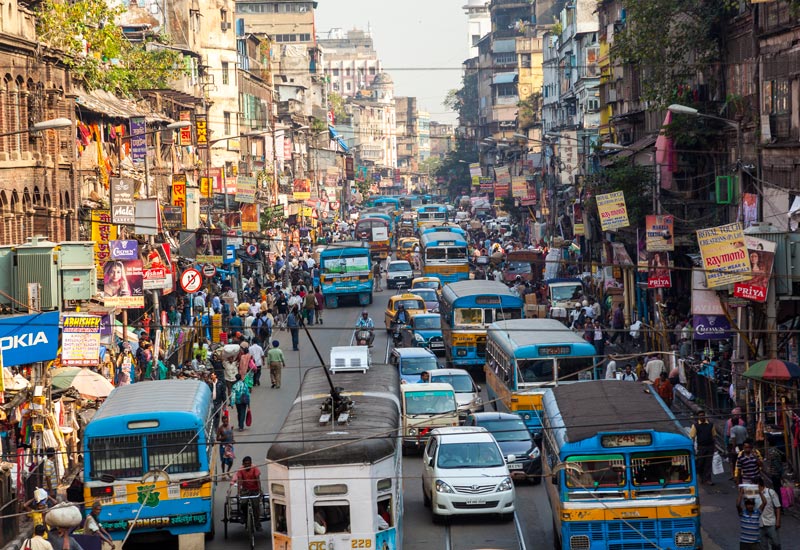Get the right experience for you. Please select your location and investor type.
IMPORTANT NEWS: Transition of investment management responsibilities
First Sentier Group, the global asset management organisation, has announced a strategic transition of Stewart Investors' investment management responsibilities to its affiliate investment team, FSSA Investment Managers, effective Friday, 14 November close of business EST.
Entropy is a measure of disorder in any system. India, on the surface, seems to have high entropy. But look beneath the surface and we find a surprising level of order and stability. This only becomes apparent if we observe India’s evolution over decades while avoiding the daily headlines that compete for our attention. We believe that such conditions make India an attractive destination for patient capital. We remain excited and hope to convey a bit of our conviction in this letter. A quick history tour is a good place to start.
India has re-elected her incumbent government, albeit in a coalition. Election results in India are important but we believe their importance has been overstated since 1991 in the context of investment returns. India’s economic progress has been sound and predictable over the last three decades, thanks largely to the 1991 consensus. Outside of the last 10 years, India has only had coalition governments. Coalition governments could drive more balanced and sustainable long-term growth.
| India’s economic progress under different governments | 2004 – 2014 (Congress-led coalition government)1 | 2014 – 2024 (BJP2 majority-led government)3 |
|---|---|---|
India GDP growth CAGR4 |
6.8% | 5.8% |
| World GDP growth CAGR | 4.0% | 3.1% |
| MSCI India Index total returns USD annualised*5 | 13.7% | 9.3% |
| Average current account deficit % of GDP6 | -1.8% | -1.2% |
| Average fiscal deficit % of GDP | 4.7% | 5.1% |
Source: Avendus Spark, as at 03 May 2024
Sustainable development in practice
Source: Avendus Spark research, 2022 & 2023 poverty data are estimates by Avendus Spark as at 31 December 2023
Annualised returns in USD 1993 - 2023
Source: Lipper as at 31 December 2023
Consistency and continuity
Upon the foundations set by the 1991 consensus, the Indian economy has expanded at a rate of 8.8% GDP a year7 over the last three decades. The 1991 consensus has ensured there is continuity in reforms. The earlier stage of reforms included liberalisation of various sectors including, but not limited to, banking, telecoms, insurance, power, mining, and infrastructure assets such as roads, ports and airports.
India private sector profits as % of GDP
Source: Ambit Capita as at 30 July 2024
Privatisation of state assets is a work in progress. It is a slow evolution but rightly so given the many stakeholders involved. Reforms such as rural work programmes, bankruptcy laws, financial access, digitisation of payments and social security, Goods and Services Tax (GST) and inflation targeting, have been conceived, implemented and strengthened by successive governments. Areas such as electricity distribution, healthcare, education and rail transportation need policy intervention and, in some cases, more private sector participation to improve efficiency, quality and access.
Consequently, private sector profits as percentage of GDP has grown over the last three decades. We believe this trend should continue as India’s development is increasingly driven by the private sector. This bodes particularly well for long-term capital allocation and investment returns. In comparison, corporate profits to GDP in the US are currently 11%8.
With strong foundations in place, a few Indian companies are beginning to think big and are aspiring to build global franchises. This is particularly exciting for long-term investors.
A goldmine for patient capital
The Indian market bears striking similarities to that of the US. Both economies are characterised by deep equity markets, open economies, long corporate histories, strong intellectual capital and entrepreneurial spirit, and political systems with checks and balances. In our view, any comparisons with China are misleading and unhelpful in the context of allocating capital long term. China and India have very different political systems and economic models. The Indian government’s role is increasingly limited to providing policy support, regulatory oversight and ensuring the benefits of development reach a larger section of society. In this context, it helps to look at the evolution of US and what the future might hold for patient capital in Indian equities.
| Evolution of the US and India | |
|---|---|
| India GDP 2023 | USD 3.4 trillion |
| India GDP per capita 2023 | USD 2,600 |
| US GDP 1982 | USD 3.3 trillion |
| US GDP per capita 1955 | USD 2,600 |
| S&P 500 returns since 1982 | 10,800% |
| S&P 500 returns since 1955 | 78,300% |
Source: Bloomberg as at 30 April 2024
We believe India should be home to a large domestic market which gives market leaders with long-term horizons fantastic opportunities. Take Blue Dart Express as an example. Blue Dart is India’s leading express logistics business with more than a 50% market share9. Blue Dart has built a reputation for trust and on- time delivery over the last four decades. This leads to sticky business. Blue Dart is following a different path to its competition by owning its assets. This allows it to focus on building network density while controlling its cost structure, a luxury its competitors will not have down the road. An ownership mindset, long-term horizon and a solid balance sheet has allowed Blue Dart to invest counter cyclically and build differently. Other logistics businesses such as FedEx and Old Dominion Freight Line have built admirable franchises in air and ground logistics respectively in the US over the last three decades. India has a similar geography and market potential. We believe Blue Dart has the right ingredients to build a large profitable domestic logistics franchise.
| Logistic business comparison | 1994 | 2024 | ||||
| Market capitalisation |
Revenue | Operating cash flow |
Market capitalisation |
Revenue | Operating cash flow |
|
|---|---|---|---|---|---|---|
| Fedex | 4.0 | 8.5 | 0.76 | 74 | 87.0 | 8.3 |
| Old Dominion | 0.14 | 0.2 | 0.02 | 46 | 6 | 1.7 |
| Blue Dart Express | 2.3 | 0.65 | 0.1 | |||
Source: Bloomberg, all numbers in USD billion as at 31 July 2024
US companies went global in the last century powered by steady cash flows from a large domestic economy. The key ingredients required for that evolution were competence and long-term ambition. We also find those ingredients in some of our favourite Indian companies.
Triveni Turbines makes steam turbines and has a leading market position in India. It is now aiming to build a global franchise. Steam turbines are a standard fixture in most manufacturing facilities and often last for over 25 years. The main challenge for customers is to ensure turbine makers are around to service their equipment. Triveni, with steady family ownership and stewardship, provides this assurance. Very few competitors can compete with their time horizons. This service mentality builds trust and is now allowing them to access new customers across the globe. Servicing provides recurring cash flows, balancing the cyclicality of selling new equipment. Steam turbines improve manufacturing efficiency and reduce carbon footprints. These attributes should support long-term demand. Businesses with quality and trust as moats make a sound case for attractive long-term returns. Companies such as Triveni Turbines and also Elgi Equipments and CG Power are laying the foundations to build world class industrial businesses.
Amidst the volatility caused by macroeconomic news and short-term events, we remain focussed on what our companies could become in the coming decades. We take inspiration from the tremendous value created by a few quality businesses in the US in the last three to four decades noting that what was required of investors was patience and sitting on the share register through economic cycles.
“Nature is not in a hurry, yet everything is accomplished” – Lao Tzu
Our investment approach is to back enduring qualities such as competent stewardship, standout cultures and sound business models tapping large future profit pools. This journey will never be linear. Some of our portfolio companies such as Mahindra & Mahindra, Tata Consultancy Services, Marico and Godrej Consumer Products have compounded returns at 18-25% in USD over the last 20 years10. During this period, India has had many macro shocks and stock market bubbles. Trading them around these events would have been detrimental to long-term returns, unless entry and exit timing was perfect. Something we are not good at. Instead, we try and be patient. The Stewart Investors Indian Subcontinent Sustainability strategy’s average turnover over the last decade is 15% and the average holding period of the top 10 holdings is 12 years11. A long-term client recently remarked “the more you trade, the more opportunities you give yourself to be wrong”. We could not agree more. On reflection we were better off sitting on our hands with some of our investments. We divest shares only when long-term valuations become expensive, the investment case has deteriorated or if there are better opportunities available.
Stewart Investors Indian Subcontinent Sustainability Strategy: Dabur investment over time
The strategy invested in Dabur in 2007 and held these shares until 2023. During this period, Dabur grew profits and dividends at 11% and 13% per annum respectively12 and the investment returned 1100%13. Dabur significantly outperformed the MSCI India index and as it was a high conviction and therefore large position in the strategy portfolio it contributed materially to the overall performance. We invested in a good business managed by competent stewards in a deeply underpenetrated consumer staples market. This time period witnessed many macro shocks such as the global financial crisis (2007-2008), taper tantrums (a surge in US treasury yields in 2013), anti-corruption protests, a change in government, demonetisation, the covid-19 pandemic and many quarters of subpar performance by Dabur. Ignoring the noise has yielded attractive returns. The investment case has remained simple but remaining invested for long periods is not easy. Patience is an integral part of our investment approach. We sold the position in Dabur in late 2023 as the valuation was expensive.
The strategy composite has delivered cumulative returns of 118% and 244% over the last 5 and 10 years to 30 June 2024 (USD net of fees). Since inception in 2003, the strategy has delivered a cumulative return of 4,209%.
% Composite performance, USD net of fees as at 30 June 2024
| Discrete annual performance | 12 months to 30-Jun-20 |
12 months to 30-Jun-21 |
12 months to 30-Jun-22 |
12 months to 30-Jun-23 |
12 months to 30-Jun-24 |
|---|---|---|---|---|---|
| Composite returns | -13.8 | 72.6 | -4.8 | 22.4 | 25.7 |
| Benchmark returns | -17.0 | 57.0 | -4.4 | 14.7 | 34.9 |
| Cumulative performance | Since launch | 10 years | 5 years | 3 years | 1 year | 6 months | 3 months |
|---|---|---|---|---|---|---|---|
| Composite returns | 4209.2 | 243.9 | 117.9 | 46.5 | 25.7 | 17.2 | 16.2 |
| Benchmark returns | 1443.3 | 151.0 | 92.7 | 47.9 | 34.9 | 17.1 | 10.4 |
| Annualised performance | Since launch | 10 years | 5 years | 3 years |
|---|---|---|---|---|
| Composite returns | 19.1 | 13.1 | 16.9 | 13.6 |
| Benchmark return | 13.6 | 9.6 | 14.0 | 13.9 |
These figures refer to the past. Past performance is not indicative of future performance. For investors based in countries with currencies other than USD, the return may increase or decrease as a result of currency fluctuations. Source for the Stewart Investors Indian Subcontinent Sustainability Composite: Stewart Investors. Composite performance is shown on a net of fees basis. Net performance figures are calculated by subtracting a model annual management fee of 0.85% from the gross performance figures. No other expenses or costs have been taken into account when calculating the net performance. Source for MSCI India Index: FactSet, total returns, gross of tax. Performance calculated from launch of Stewart Investors Indian Subcontinent Sustainability composite on 1 January 2003.
These returns have been achieved thanks to outstanding stewards who are patiently building high quality businesses over decades. Such companies are an exception not the rule. The tail of our portfolios mainly serves to help us find these gems to which we can allocate a significant proportion of capital.
Chaos does not mean risk
The political chaos and the steady news flow emanating from India’s sensationalist media is often perceived as a risk. We disagree. It is no different to what we see in any other democratic society. Au contraire, it helps long- term capital allocators with much needed transparency. India has broadly remained stable beneath this chaotic surface. A heterogeneous society, a competitive federal system, independent institutions that provide checks and balances and a healthy tug of war between various stakeholders forms the bedrock for long-term sustainable development.
The region is not without its risks. Tricky borders, climate change, rising inequality and rapid urbanisation are challenges to growth and productivity. Some of these problems can be addressed by sensible policy and patient capital. This has been the case since 1991.
Sashi Reddy
Stewart Investors
Foot notes
1 March 2004 to March 2014
2 BJP = Bharatiya Janata Party.
3 March 2014 to March 2024.
4 CAGR = Compound Annual Growth Rate.
5 Dates for MSCI India index returns: 13 May 2004 to 16 May 2014. The second column is 16 May 2014 to 03 May 2024.
6 GDP = Gross Domestic Product.
7 Source: World Bank.
8 Source: Ambit Capital as at 29 July 2024.
9 Source: Blue Dart Express, Investor Presentation, 25 July 2024.
10 Bloomberg as at 30 April 2024
11 Source: Stewart Investors as at 30 June 2024.
12 Source: Dabur’s Financial Report
13 Source: Stewart Investors
Important Information
The information contained within this material is generic in nature and does not contain or constitute investment or investment product advice. The information has been obtained from sources that First Sentier Investors (“FSI”) believes to be reliable and accurate at the time of issue but no representation or warranty, expressed or implied, is made as to the fairness, accuracy, completeness or correctness of the information. To the extent permitted by law, neither FSI, nor any of its associates, nor any director, officer or employee accepts any liability whatsoever for any loss arising directly or indirectly from any use of this material.
This material has been prepared for general information purpose. It does not purport to be comprehensive or to render special advice. The views expressed herein are the views of the writer at the time of issue and not necessarily views of FSI. Such views may change over time. This is not an offer document, and does not constitute an investment recommendation. No person should rely on the content and/or act on the basis of any matter contained in this material without obtaining specific professional advice. The information in this material may not be reproduced in whole or in part or circulated without the prior consent of FSI. This material shall only be used and/or received in accordance with the applicable laws in the relevant jurisdiction.
Reference to specific securities (if any) is included for the purpose of illustration only and should not be construed as a recommendation to buy or sell the same. All securities mentioned herein may or may not form part of the holdings of First Sentier Investors’ portfolios at a certain point in time, and the holdings may change over time.
In Hong Kong, this material is issued by First Sentier Investors (Hong Kong) Limited and has not been reviewed by the Securities & Futures Commission in Hong Kong. In Singapore, this material is issued by First Sentier Investors (Singapore) whose company registration number is 196900420D. This advertisement or material has not been reviewed by the Monetary Authority of Singapore. First Sentier Investors, FSSA Investment Managers, Stewart Investors, RQI Investors and Igneo Infrastructure Partners are the business names of First Sentier Investors (Hong Kong) Limited. First Sentier Investors (registration number 53236800B), FSSA Investment Managers (registration number 53314080C), Stewart Investors (registration number 53310114W), RQI Investors (registration number 53472532E) and Igneo Infrastructure Partners (registration number 53447928J) are the business divisions of First Sentier Investors (Singapore).
First Sentier Investors (Hong Kong) Limited and First Sentier Investors (Singapore) are part of the investment management business of First Sentier Investors, which is ultimately owned by Mitsubishi UFJ Financial Group, Inc. (“MUFG”), a global financial group. First Sentier Investors includes a number of entities in different jurisdictions.
MUFG and its subsidiaries are not responsible for any statement or information contained in this material. Neither MUFG nor any of its subsidiaries guarantee the performance of any investment or entity referred to in this material or the repayment of capital. Any investments referred to are not deposits or other liabilities of MUFG or its subsidiaries, and are subject to investment risk, including loss of income and capital invested.




